Black Cutworm and Common Armyworm Moth Numbers Rising in Western Counties
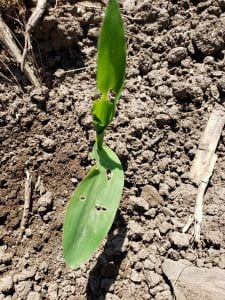
Black Cutworm (BCW) catches significantly increased, especially in our western counties. We started monitoring degree-days (base 50°F) on May 9. Every location is now above 100 DD so the earliest eggs have hatched. Pin hole feeding on the corn leaves could possibly be observed. The larger flights this week means that it could be a busy June scouting fields. Common Armyworm (CAW) continue to be low, which is great. There are some larger flights being picked up Wyoming and Livingston counties so it would advised to be scouting for early CAW lower leaf feeding in small grains.
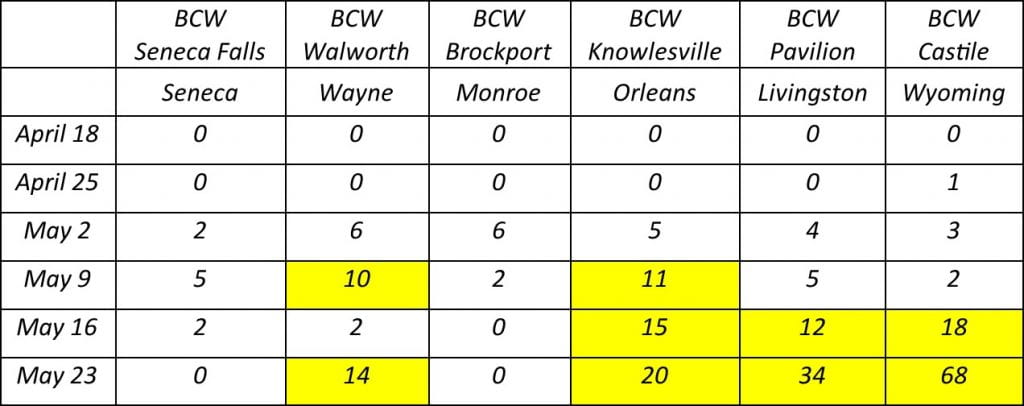
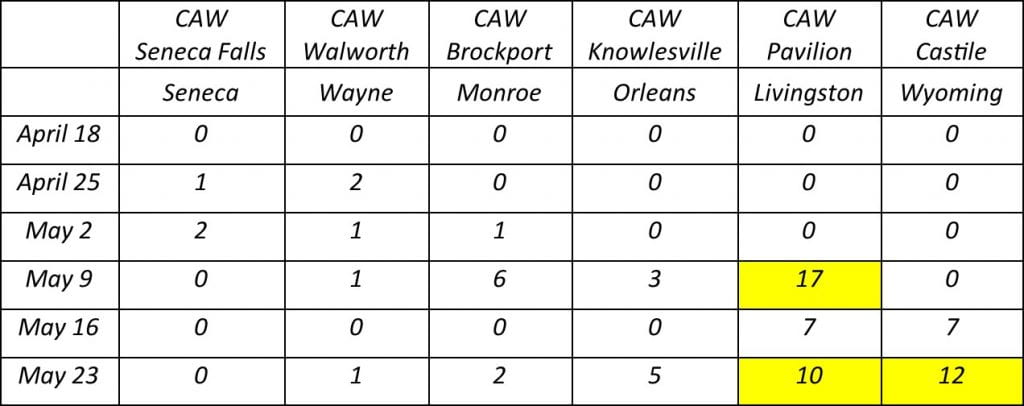
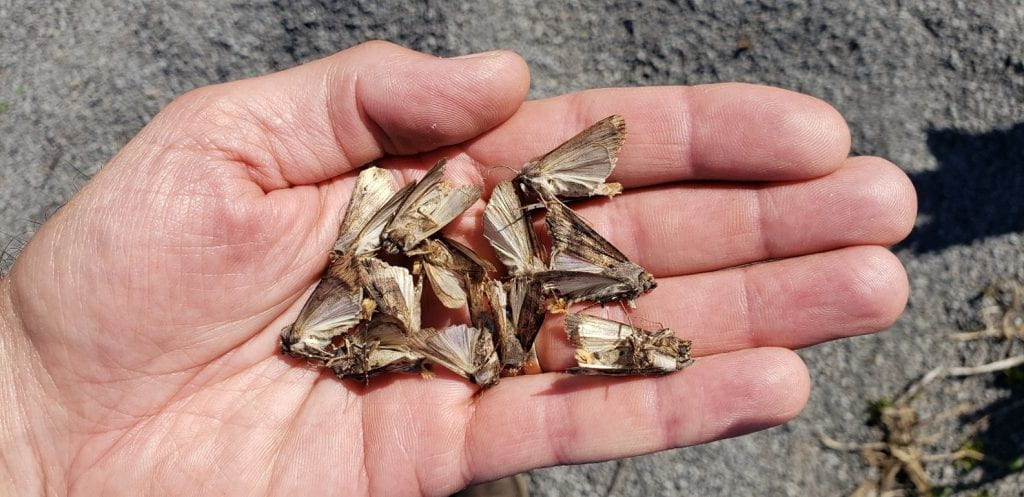
- Egg hatch around 90 Degree Days
- Plant cutting around 300 Degree Days
- Degree Day data from Network for Environment and Weather Applications, NEWA
Fusarium Head Blight Commentary, Gary Bergstrom, Cornell, May 21
Much of the winter wheat in New York is at boot stage and is expected to initiate flowering during the first week in June. The DMI (FRAC Group 3) containing fungicides Caramba, Prosaro, or Miravis Ace (latter includes a FRAC Group 7 fungicide) are the most effective fungicides for suppression of FHB and DON contamination when applied at flowering (emergence of yellow anthers on heads). A flowering application of these fungicide products should be based on Fusarium head blight (FHB) risk as well as the risks of powdery mildew, rusts, and fungal leaf blotches in the upper canopy based on scouting of individual fields. There is an application window of approximately 7 days from the beginning of flowering in which reasonable FHB and DON suppression can be expected. Severe powdery mildew has been observed in some mildew-susceptible varieties. Check the Fusarium Risk Assessment Tool and your local weather forecast frequently as your winter wheat crop approaches heading and flowering.
Alfalfa Heights
Height indicators alfalfa and grass for NDF content are below:
- In general we say 100% grass stands should be cut when nearby alfalfa is 14 inches tall to achieve the desired 50% NDF.
- Begin cutting 50/50 mixed alfalfa and grass stands when nearby alfalfa is 22 inches tall for the desired 44% NDF.
- Begin cutting 100% alfalfa stands when alfalfa is 28 inches tall for desired 40% NDF.
As of today May 27, 2021 alfalfa heights averaged 27-32 inches across locations. If you haven’t started cutting 100% alfalfa stands, you should. Many fields have already been harvested. Continue to monitor 2nd cutting regrowth as Alfalfa weevil (AW) feeding continues to be noticeable. It is important that you get first cutting in a timely manner for quality purposes, so please communicate in advance with your team on how you are going to prep fields, plant and successfully harvest 1st cutting.
Next report will be June 3rd.
Cooler Temperatures and Early Post Herbicide Applications
Nighttime temperatures for the weekend are dropping down into the 40’s. When temperatures dip below 40º it makes it more difficult for the plants to metabolize nutrients from the soil and weeds to absorb herbicides. Ineffective early post herbicide applications could occur if areas drop below 40º. Read and follow the label for proper application temperatures. If you are going out with an early post herbicide application plan to scout those fields 7-14 days post application to see how well weeds absorbed the herbicide. This will help you determine if another application will be necessary and whether or not a foliar nutrition product could be added.
2021 Small Grains Management Virtual Field Day – June 3rd
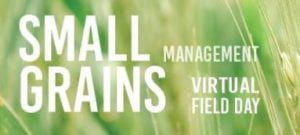 Due to COVID-19 restrictions, we are not able to hold our traditional, in-person Small Grains Management Field Day at Cornell’s Musgrave Research Farm this June. However, we invite you to participate in our second virtual Small Grains Field Day via Zoom. This will be an opportunity to learn about the latest in small grains development, management, and markets. All participants on the call will be invited to ask questions and make comments. No registration is required. More information and Zoom instructions are available at: https://blogs.cornell.edu/ccefieldcropnews/2021/05/19/2021-small-grains-management-virtual-field-day-to-be-held-june-3rd/#Join_Zoom_Meeting. So please plan to log-in to Zoom before 10 AM on June 3. Looking forward to hearing and seeing you on Zoom!
Due to COVID-19 restrictions, we are not able to hold our traditional, in-person Small Grains Management Field Day at Cornell’s Musgrave Research Farm this June. However, we invite you to participate in our second virtual Small Grains Field Day via Zoom. This will be an opportunity to learn about the latest in small grains development, management, and markets. All participants on the call will be invited to ask questions and make comments. No registration is required. More information and Zoom instructions are available at: https://blogs.cornell.edu/ccefieldcropnews/2021/05/19/2021-small-grains-management-virtual-field-day-to-be-held-june-3rd/#Join_Zoom_Meeting. So please plan to log-in to Zoom before 10 AM on June 3. Looking forward to hearing and seeing you on Zoom!




